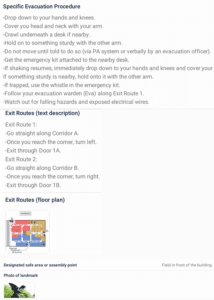What is an Emergency Evacuation Plan?
An emergency evacuation plan is a set of procedures developed by employers to help facilitate safe evacuations in case of workplace emergencies. Emergency evacuation plans usually contain exit routes, locations of designated safe areas, and the specific steps to follow for each type of emergency.
What is the Purpose of an Emergency Evacuation Plan?
The purpose of an emergency evacuation plan is to ensure the safety of employees and visitors during an emergency. Since the nature of an emergency can’t be known beforehand, employers have a duty to protect employees regardless of what may happen. This entails preparing for different scenarios where employees could be exposed to life-threatening danger.
The Types of Emergencies to Prepare For
According to the US Occupational Safety and Health Administration (OSHA), a workplace emergency is any unforeseen situation that threatens the safety of employees, customers, and their environment, as well as disrupt or forcibly shuts down operations. Some workplace emergencies that require immediate evacuation and a corresponding emergency evacuation plan include:
- Floods and hurricanes
- Tornadoes
- Fires and explosions
- Chemical spills, radiological accidents, and toxic gas leaks
- Civil disturbances and moments of unrest
- Workplace violence resulting in bodily harm, trauma, and destruction of property that can put others at risk
When is Evacuation Needed?
According to the Occupational Safety and Health Administration (OSHA), while any type of emergency may require an evacuation, it should still be decided on a case-by-case basis. To make this decision much quicker during an actual emergency, employers must assess the vulnerability of their workplaces to the different types of emergencies in advance.
Ask the following questions:
- How likely is it for this type of emergency to occur in the area/region where the workplace is located?
- If the emergency occurs, what would be the worst possible impact on the safety of employees and visitors?
- How prepared is the workplace to handle this emergency?
What to Consider When Creating Your Emergency Evacuation Plan
Although each emergency evacuation plan is different, the process for creating them is similar across different industries. Some things you need to consider when creating your emergency evacuation plan are:
- Regulatory requirements: Make sure that your plan meets all necessary legal requirements for your industry and location.
- Your organization’s needs: Consider the size and complexity of your organization and is appropriate for your needs.
- Customizability: Look for a template or digital solution that allows you to customize your emergency evacuation plan templates as needed.
- Chain of command: Create and implement a clear chain of command to follow in case of emergencies, and ensure everyone is aware of their respective roles and responsibilities
Improve your EHS Management
Cultivate a safe working environment and streamline compliance with our EHS solutions.
Explore nowHow to Write an Emergency Evacuation Plan
For employers that need a guide on how to write an emergency evacuation plan for their workplace, refer to the steps below:
Step 1: Evaluate the Emergency
Assess the vulnerability of your workplace to the specific emergency. For example, flooding, which is the most common natural disaster in the US, may pose a greater risk to workplaces situated on lower levels or flood-prone areas. Additionally, certain natural disasters tend to occur in specific areas and it’s important for you to know if your workplace is in a higher risk area.
Determine if evacuation or shelter-in-place is more suitable for this type of emergency. Usually, shelter-in-place is recommended for emergencies wherein the danger is outside of or in close proximity to the workplace. Examples of emergencies requiring shelter-in-place are chemical incidents across the street from or nearby the workplace and tornado warnings.
Identify the need for greater resources or assistance such as special equipment and/or extra facilities for handling a critical emergency. Consider the possible need for consultation with experts and/or local emergency services. This is especially crucial for workplaces in hazardous environments.
Step 2: Determine Exit Routes
Map out exit routes in the floor plans. Follow these best practices from OSHA:
- A workplace must have at least 2 exit routes.
- Exit routes must be as far away as practical from each other.
- Doors should swing out in the evacuation direction and be unlocked from the inside.
Walk through the exit routes yourself to check if it can facilitate a safe and efficient evacuation. Remember that exit routes should have adequate space (since employees may not follow a one-line policy during an actual emergency).
Step 3: Identify Safe Areas
Scout a potential safe area or assembly point. Ask the following questions while you’re there:
- Is this area usually and relatively safe?
- Is this area well-lit?
- Is it easy to access emergency services from this area? (the area is near a hospital, etc.)
- Does this area have good cell service / signal?
- Will employees have difficulty finding this area once they exit the workplace?
- Could this area ever be obstructed during an emergency? (trucks blocking the road, etc.)
Identify instances wherein the area could still be unsafe or the danger of the emergency could possibly reach the area. Also consider the number of employees you’ll be evacuating to this safe area. If possible, ask neighboring offices or establishments if they will also be using this area for evacuation.
If you decide to share the area with another workplace during evacuations, ask for their number of employees and check if both your employees and their employees will fit in the designated safe area.
Step 4: Develop Evacuation Procedures
Once you have decided on the exit routes and on the designated safe area, develop a step-by-step evacuation procedure for each area in the workplace. For example, if an employee is in room 1, they must follow specific steps to go through exit route 1 and then get to the designated safe area.
If you have more than 25 employees, consider establishing a procedure for employees to digitally check-in and verify that they are safe (as opposed to or to supplement the in-person headcount done by the evacuation wardens). Identify protocols for what should be done once all employees have been accounted for and if the emergency continues or increases in severity.
Step 5: Discuss with Employees
Hold a meeting with employees to discuss the appropriateness of exit routes, safe areas, and evacuation procedures. Note down suggestions, comments, and points for further clarification. Revise the emergency evacuation plan based on employee feedback. Then, present the revised emergency evacuation plan to employees for approval.
Step 6: Assign Responsibilities
Assign evacuation officers, wardens, and assistants. Establish a chain of command:
- Evacuation Officer 1 – the coordinator or leader of the evacuation; has the authority to make decisions during emergencies; and is responsible for coordinating with outside emergency services.
- Evacuation Officer 2 – If Evacuation Officer 1 is unavailable during an emergency, Evacuation Officer 2 assumes the role of evacuation coordinator.
- Evacuation Officer 3 – If both Evacuation Officer 1 and 2 are unavailable during an emergency, Evacuation Officer 3 assumes the role of evacuation coordinator.
- Evacuation Wardens – Wardens direct employees to proper exit routes until they reach the designated safe area. OSHA recommends that for every 20 employees, you assign one evacuation warden. Alternatively, you may assign one evacuation warden per floor or for each area in the workplace.
- Assistants – They check if employees are following the warden and if anyone is left behind or needs help. They may also monitor the safety of employees assigned to shut down operations before evacuating.
Once the plan has been approved by employees, distribute copies (preferably digital) to all employees (including part-time) as well as frequent visitors and third-party workers.
Step 7: Conduct Training Exercises
Set a date for employee training on the specific emergency evacuation plan. This may include test runs, drills, and other practical exercises. Set intervals for training (e.g., every 3 months). Consider enrolling employees in emergency training programs provided by credible organizations such as the American Red Cross or the local fire department.
It would also be very beneficial to conduct your own internal training through a digital app, such as a safety management app. Consider using Training by SafetyCulture (formerly iAuditor) to implement your own training exercises through engaging in online courses for emergency evacuation procedures and the right planning necessary. With this, you can have more detailed training exercises, ensuring all employees are aware of the right safety steps.
Step 8: Review and Update the Plan as Needed
Regularly review and update the emergency evacuation plan. Changes in the workplace will also warrant a review and update of the plan. Additionally, feedback or results from training exercises can lead to major revisions in the plan. For each update and revision, employees must be notified and retrained accordingly.
Create Your Own Emergency Evacuation Plan
Eliminate manual tasks and streamline your operations.
Get started for FREESpecific Emergency Evacuation Plans
Learn more about specific emergency evacuation plans below:
How to Write a Written Emergency Evacuation Plan for Family Child Care Homes
Special consideration must be given to the evacuation of children from family child care homes since children cannot be responsible for their own personal safety.
Unlike a home setting where parents or guardians only need to focus on the evacuation of 2 or more children, teachers in family child care homes will often be responsible for large groups of children.
Step 1: List the contact details of local emergency services.
Step 2: Identify the level of the home where the children are cared for, and if applicable, the other areas they have access to.
Step 3: Determine how the children will be evacuated (i.e., all together or separately and how the teacher will move the children to the evacuation site, etc.)
Step 4: Identify the following evacuation sites and list their addresses, person/s to contact, and their phone numbers.
- in the neighborhood in case of fire;
- out of the neighborhood in case of an explosion or contained flooding; and
- out-of-town in case of a hurricane or widespread flooding.
Step 5: Inform parents about evacuation sites and specify procedures for parent reunification.
Warehouse Emergency Evacuation Plan
Since warehouses are extremely susceptible to fires, employers that own or manage warehouses should take great care in preparing an evacuation plan for fire emergencies. A warehouse emergency evacuation plan should contain the following elements:
- Fire alarm signal
- Diagram of exit routes
- Location of the nearest exit
- Placement of fire extinguishers and PPE with the right safety signs
- Location of the designated safe area or fire assembly point
- Procedures for accounting for warehouse staff and visitors
- Contact details of the local fire department
Factory Emergency Evacuation Plan
Safe evacuation from factories can be especially challenging since some processes in manufacturing involve Highly Hazardous Chemicals (HHCs) and the use of dangerous equipment. To be adequately prepared for any type of emergency, a factory must have an emergency evacuation plan with the following elements:
- Specific conditions that require full evacuation or partial evacuation
Example 1: If there is a liquid spill of Chemical A, all employees must evacuate immediately.
Example 2: If particles of Chemical B are dislodged from its container, only the employees in the room must evacuate.
- Procedures for simultaneous and interconnected emergencies
Example 1: If a combustible gas is released and an equipment malfunction can provide a source of ignition, then a qualified operator must quickly repair or isolate the equipment.
Example 2: If an earthquake causes the container of a flammable chemical to be broken and it causes a fire, then the evacuation coordinator must put out the fire even while the earthquake is ongoing.
- Procedures for emergency shutdown actions and operations
Construction Site Emergency Evacuation Plan
A construction site emergency evacuation plan should include the following elements:
- Provision of readily available first aid supply kits
- Provision of facilities for quick drenching and flushing of the eyes and body (if exposure to corrosive materials is possible)
- Provision of equipment to transport injured employees to emergency care
- Locations of unobstructed exit routes from every building and structure where employees are working
- For construction work in open excavations, provision of emergency rescue equipment such as a respirator, safety harness and lifeline, or basket stretcher.
- For construction of underground tunnels, shafts, chambers, and passageways:
- Provision of check-in/check-out procedures (if there is a potential environmental or structural failure hazard)
- Provision of means to summon emergency assistance to an employee working alone, not being observed, or who cannot request assistance by voice
- Provision of hoist shafts that include power-assisted hosting capability (if regular hoisting means cannot operate during an electrical power failure)
- Provision of acceptable portable hand lamp or cap lamp to each underground employee for emergency use (if emergency lighting is insufficient)
- Availability of National Institute for Occupational Safety and Health (NIOSH) approved self-rescuers to all employees
- Designation of at least one employee to be on duty above ground to summon emergency aid
Emergency Evacuation Plan Sample
Below is a sample emergency evacuation plan for earthquakes:
View the full version of the emergency evacuation plan sample for earthquakes PDF here.
Tips for Preparing an Emergency Evacuation Plan
For employers that want to be ready for anything and completely protect employees from harm, follow these 5 tips in preparing an emergency evacuation plan:
- Ensure that the workplace has a system for receiving emergency notifications from local and national authorities.
- Check if internal emergency alert systems and methods of emergency communication are working, reliable, and fast.
- If necessary, provide go bags for employees to take when evacuating. At the minimum, go bags should contain a light snack, a bottle of water, a flashlight, and a whistle.
- As much as possible, automate the shutdown of operations as well as the saving or transferring of information. For example, when the evacuation coordinator presses a button, systems immediately start shutting down so that no employees need to stay behind to manually do this or for information to automatically save to the Cloud.
- Use digital emergency management and evacuation plans. While posting paper emergency evacuation plans in areas around the workplace is still helpful, employees won’t be able read them unless they are standing right in front of where the plans are posted.
SafetyCulture (formerly iAuditor): A Tool for Creating Emergency Evacuation Plans
With SafetyCulture, creating and distributing your organization’s emergency evacuation and action plans has never been easier. Whether you’re a small business, mid-market company, or enterprise, we have the perfect solution tailored to your needs.
Key features:
- Access to Free Evacuation Plan Templates
- Customization Options with Template and Reports
- Digital Emergency Evacuation Plans
- Effortless Sharing
- Mobile Accessibility
SafetyCulture has helped businesses around the world achieve
*Reported in Forrester’s study: The Total Economic Impact™ of SafetyCulture’s Operations Platform
FAQs about Emergency Evacuation Plan
There are 5 things to always be prepared with when evacuating. These are:
- People
- Prescriptions or medications
- Papers and documents
- Priceless items
- Personal needs





